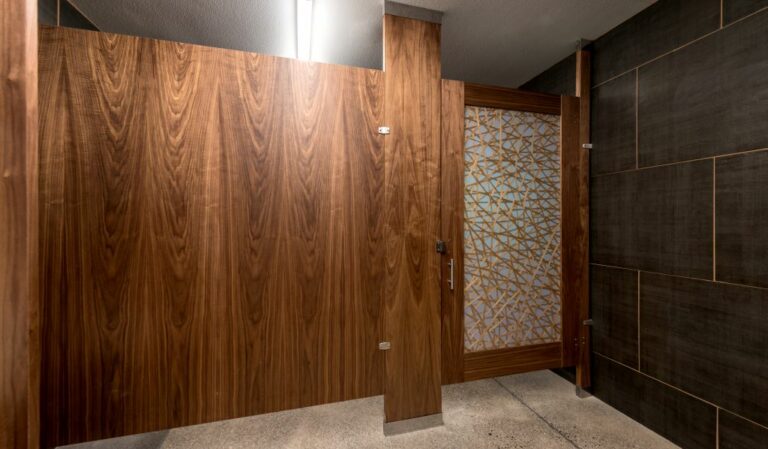At Ironwood we believe in high-quality, cost-effective, and sustainable solutions. Wood veneer toilet partitions are a good fit with these values because of their aesthetic appeal and eco-friendliness. There are, however, several things to keep in mind when specifying real wood for toilet partitions. In this article, we cover wood veneer partition considerations, address some common misconceptions, and briefly touch on alternative options.
Wood Veneer Aesthetics
Wood veneer is made from thin slices of real wood. Its unique grain, texture, and tone give wood veneer natural beauty, an authentic look, and a rich, high-end appearance. Wood veneer also offers the flexibility of being stained to match other elements of a restroom. Finally, the veneer’s grain can be matched in many ways (book-matched, random-matched, etc.). Ironwood veneer partitions have the veneer leaves either book or slip-matched across the face.
Wood Veneer Cost
Wood veneer toilet partitions are typically two to four times (depending on wood species) more expensive than comparably sized laminate or powder-coated metal partitions. Why is veneer so much more expensive? Because the raw wood veneer itself is more expensive, plus real wood has the additional steps of sanding, staining, and finishing. Wood veneer is, however, the least expensive of natural materials, such as stone or solid wood partitions.
Wood Veneer Sustainability
Wood veneers from responsibly harvested trees are a renewable, environmentally responsible choice compared with other partition materials such as plastic, or metal. This is particularly true of reconstituted, or “recon”, wood veneer products (see below).
Color and Pattern Variability
Natural wood veneer has variations in grain and color. Ironwood’s veneer suppliers strive to source materials which are uniform across sheets to minimize this variation. However, since individual components are manufactured from different veneer sheets, grain and color variation between components (doors, panels, pilasters, screens) is to be expected.
Replacement and Maintenance
A significant challenge with natural wood materials is the difficulty of matching grain and color when replacing parts. If a part is damaged during shipping or installation, or simply needs to be replaced after years of use, it is nearly impossible to create a perfect match. Reconstituted wood veneers are one solution that can offer a more consistent appearance in replacement parts.
Reconstituted Wood Veneer
Reconstituted wood veneer (or “recon”), when compared with real wood veneer, is more consistent and has a better yield per tree. Moreover, recon is better suited for part replacements because the dyes used to manufacture recon are less prone to fading than real wood stains.
Recon is typically created from fast-growing species of wood grown on plantations, making it an eco-friendly choice.
It is worth noting that recon does not have the same depth and richness that real, natural wood veneers can provide. It is also difficult to stain recon to match other elements of a restroom. Other limitations include limited availability, limited sheet sizes, and longer lead times. Still, for many applications, it can be a good choice.
Solid Wood Partitions
While solid wood may seem like a luxurious choice, it comes with several drawbacks that make it less suitable for commercial applications. Most parts, especially doors and panels, will require multiple pieces of wood to be spliced together, as acquiring a single, wide piece can be prohibitively expensive. This can lead to an inconsistent grain pattern even within a given component. Solid wood also can move due to the transition from the environment in which it was produced to the environment in which it is installed. This movement causes warping, splitting, and widening of gaps in seams. Finally, solid wood products clearly require much more material and therefore have more impact on the environment than veneer products.
Conclusion
Designers should be aware of the limitations and variations inherent to natural wood materials and set appropriate expectations for their clients. By considering alternatives like recon, designers can expand their range of sustainable and consistent options for bathroom stall design.
